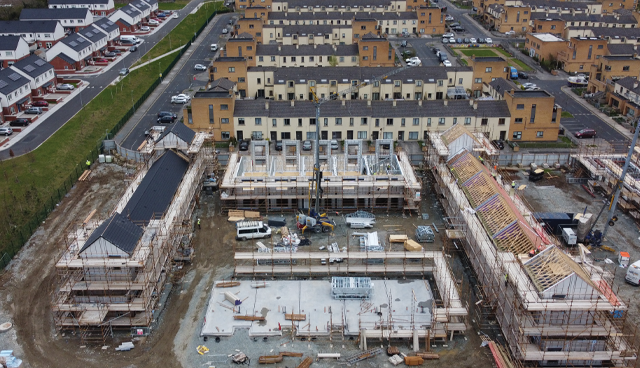
Affordable and social housing underpin major efforts in Ireland’s youngest county
4th July 2022
Proactively supporting the delivery of housing in Ireland
4th July 2022RPZs containing rent increases

The future use of rent controls “should be considered an essential part of the rental market policy tools”, an Economic and Social Research Institute (ESRI) study has suggested.
The recommendation comes after an assessment by the ESRI found that the introduction of Rent Pressure Zones (RPZs), aimed at holding rent increases to 4 per cent a year in designated urban areas between 2017 and 2020, has been successful in limiting rent inflation.
The report warns that any removal of stabilisation measures would likely lead to further upward price pressure on a rental market already likely to experience considerable pressure as the economy looks to recover from the profound effects of the Covid-19 pandemic.
According to the research, rent in pressure zones would be some 2 per cent higher on average if controls were not implemented, however, it also found that more than one third (34 per cent) of landlords within RPZs rose rent rates above the allowable limit.
While landlords are allowed to apply for exemption from that rent increase cap under certain criteria (just over 800 exemptions have been registered since July 2019), the ESRI said that it could not ascertain whether all the exceeding rises were legitimate or whether they represented breaches of the regulation due to “data gaps” in Residential Tenancies Board (RTB) statistics.
Rent stabilisation measures were first introduced into the Irish private rental sector in 2016 to address concerns around affordability challenges for private renters amidst a period of rapid inflation in rental process. Specific areas designated as RPZs were imposed with a 4 per cent annual cap in rental inflation. Since then, a large number of additional areas have been classified as RPZs and in late 2021, a maximum annualised increase of 2 per cent was introduced due to rising general inflation in the economy.
Although research for the study was carried out prior to the lowering of the rate, the report’s authors are confident “the broad nature of the research as well as the backward-looking review of events and existing studies means that the findings apply regardless of any changes to the specific calibration of the caps”.
The ESRI study looked at the implementation of similar measures in other countries and assessed that there was “clear economic rationale for price stabilisation mechanisms in the Irish rental market”. The introduction of rent cap measures had been met with opposition because regulation omitted new tenancies, which critics felt were responsible for driving up rents.
While highlighting the benefits of RPZs for existing tenants, the ESRI says that such measures come with “supply-side health warnings” as they have been shown to lower investment and maintenance in buildings and lower overall rental supply in certain cases.
“This often affects potential new tenants. Exemptions to the rules in the Irish case for new supply and dwelling upgrades are correctly targeted to help avoid these side effects,” it states.
The ESRI’s Associate Research Professor Conor O’Toole says: “The adoption of RPZs in an Irish context has helped to limit the scale of rental inflation since their introduction in late 2016. Indeed, it is likely rental inflation would accelerate further without these measures.
“However, international evidence would suggest that while these types of measures are justified in many contexts, strict price caps risk lowering supply and upkeep in the medium term which must be borne in mind by policymakers.”
The ESRI’s microdata analysis identifies more properties with a growth rate above the 4 per cent cap than the number of registered exemptions and recommends that further efforts to ensure higher rates of reporting exemptions would be beneficial, alongside improved data collection and monitoring.
At present two types of exemptions from rent price caps in RPZs are permitted. The first, when a property is a new build or new to market and the second, when the nature of a property has been substantially changed (targeted at maintenance, upkeep, and energy efficiency investments).
The report finds that almost half of tenancies in zones introduced in 2016/2017 and those introduced in 2019 had increases in rents that were above the average 4 per cent cap.
Most of the current registered exemptions are Type 1 exemptions (+600) and the majority of these (76 per cent) are in Dublin. Of the Type 2 exemptions, 40 per cent are for major energy efficiency upgrades.
The ESRI study suggests that while the targeting of exemptions appears calibrated to offset the type of maintenance and upkeep side-effects seen in existing literature and should therefore form part of any ongoing stabilisation programme, the low number of registered exemptions when compared with the number of tenancies experiencing rent rises above the 4 per cent cap suggests the need for continued efforts to increase compliance and monitoring of the scheme.
The report concludes: “With the continued excess demand for housing, and the potential for a sustained recovery in the Irish economy, it is likely that these market factors would put considerable upward pressure on rental prices in a scenario where stabilisation mechanisms were removed entirely.
“The continued usage of these mechanisms is likely to be required and should be considered an essential part of the rental market policy tools in future. Such stabilisation measures should continue to be cognisant of the potential for supply-side externalities, but they can also be seen as a valid intervention to reduce inflationary pressures in the housing market.”







